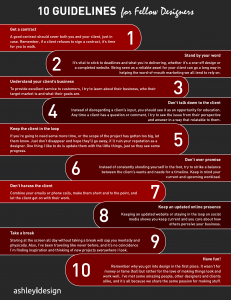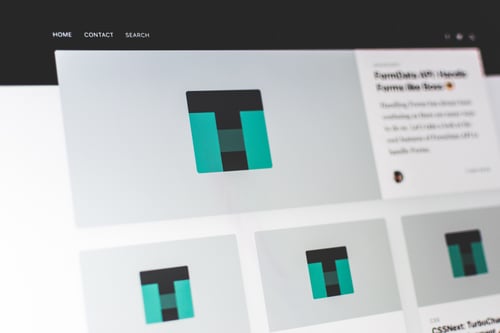
10 Guidelines For Fellow Designers
Following in the steps of a previous post, 10 Guidelines for the Ideal Client, this article aims to aid fellow designers with basic guidelines for working with clients. These will help maintain professionalism and a healthy relationship with those you design for and there’s an image at the bottom of this post to share with others.
Get a contract
The MOST important thing a designer needs to do is get it in writing. Without a contract you might as well be roadkill, since anyone can take your work and run away with it. A good contract should cover both you and your client, just in case. If you've never written a contract before, the AIGA has a good start for you: Standard Form of Agreement.
Remember, if a client refuses to sign a contract, it's time for you to walk.
Stand by your word
It’s vital to stick to deadlines and what you’re delivering, whether it’s a one-off design or a completed website. Being seen as a reliable asset for your client can go a long way in helping the word-of-mouth marketing we all tend to rely on.
Understand your client's business
In working with clients I’ve come to learn a lot about bike shops, waste management and the heating and cooling industries, sometimes more than I bargained for. This is because to provide excellent service to customers, I try to learn about their business, who their target market is and what their goals are.
Don't talk down to the client
Instead of disregarding a client’s input, you should see it as an opportunity for education. Any time a client has a question or comment, I try to see the issue from their perspective and answer in a way that relatable to them. When there’s a server upgrade I don’t need to explain the details, but rather any impact it may have on a client’s site.
Keep the client in the loop
Like above, keep your client in the loop. If you're going to need some more time, or the scope of the project has gotten too big, let them know. Just don't disappear and hope they'll go away, it'll ruin your reputation as a designer. One thing I like to do is update them with the little things, just so they see some progress. Communication with the client is key. Keep in touch after the work is done; Christmas cards or email lists help build the relationship.
Don't over promise
We’d like to think that every project goes smoothly, the client loves the first revision and everything can get done in a week, but that’s not true to life. Instead of constantly shooting yourself in the foot, try to strike a balance between the client’s wants and needs for a timeline. Keep in mind your current and upcoming workload.
Don't harass the client
Combine your emails or phone calls, make them short and to the point, and let the client get on with their work. You don't want the them to remember you as someone who sent needless emails all day, asking question after question because you forgot to take notes at the first meeting.
Keep an updated online presence
Some days I’m a Tweetaholic, keeping in touch with fellow designers and joining online chats when I can. Keeping an updated website or staying in the loop on social media shows you keep current and you care about how others perceive your business.
Take a break
Throughout the day I use the Pomodoro technique for getting things done, taking a break every so often to stretch, make more coffee or play with the dogs. Staring at the screen all day without taking a break will sap you mentally and physically. Another thing is you really need to travel more. I’ve been traveling like never before, and it’s no coincidence I’m finding inspiration and thinking of new projects everywhere I look.
Have fun!
Remember why you got into design in the first place. It wasn’t for money or fame (ha!) but rather for the love of making things look and work well. I’ve met some amazing people, other designers and clients alike, and it’s all because we share the same passion for making stuff.
Your Turn
Do you think I’m missing something or are totally off-base? Have you worked with a designer that needs to see this post? Let me know!
Here’s a graphic version of the post to share with others or print out for the office:
I help businesses and marketers build marketing and sales systems that drive leads and scale with ease.
Not sure where to start? Take my marketing quiz and get personalized next steps.




